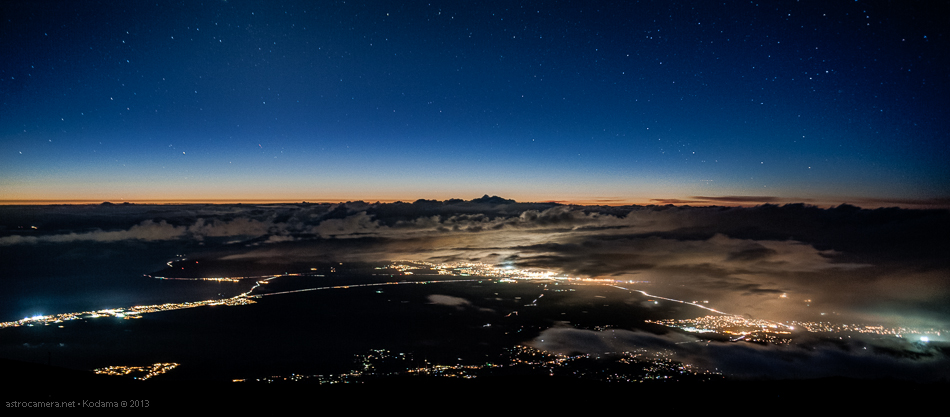
Nikon D700 / ISO 1600 / Tamron zoom lens @ 75mm / f/2.8 / HDR combine 1,2,4,8 sec. Looking west at the city lights of central Maui from Mt. Haleakala (elevation 10,000 ft.) on Maui -- To the right is the northern side of the island (Kahului, Wailuku), and to the left, the southern side resort areas of Kihei and Maalaea. West Maui (center of the shot) is shrouded in clouds. The sun had set about an hour earlier. 
Click on the image for an interactive 360x180° panoramic view. Above is a first try at a panoramic night shot I had been planning for about 10 years. Finally at about 9:30pm the time, technology, and conditions converged, allowing me to take my shot. The special condition for this panoramic shot was that it was taken when the Milky Way was positioned right on the horizon in all directions. Because we're positioned near the edge of our galaxy, the center of the Milky Way is thicker and more obvious in that direction (towards the summit observation building). Further south, about half-way towards the buildings of the Haleakala observatories, the Southern Cross and Coalsack features are visible. Observers further north of Hawaii never see these objects. Above the glow of the cities of central Maui, the zodiacal light can be seen. This is sunlight scattering off the dust in our solar system, which is mostly in the plane of orbit for the planets and asteroids.
 Nikon D700 / ISO 1600 / Tamron zoom lens @ 75mm / f/2.8 / 30 sec.
Nikon D700 / ISO 1600 / Tamron zoom lens @ 75mm / f/2.8 / 30 sec.
Above is a closeup of the military satellite (and debris) tracking facilities which provide warnings to everyone when a potential collision could occur in orbit. The silver cylinder is an interesting telescope housing. When in use, the sides retract, leaving the telescope in the open, silently slewing from place to place in the sky. |
 |

|
Haleakala Skies
|